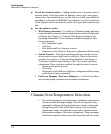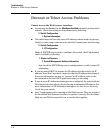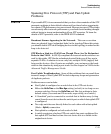
C-10
Troubleshooting
Unusual Network Activity
IGMP-Related Problems
IP Multicast (IGMP) Traffic That Is Directed By IGMP Does Not Reach
IGMP Hosts or a Multicast Router Connected to a Port. IGMP must
be enabled on the switch and the affected port must be configured for “Auto”
or “Forward” operation.
IP Multicast Traffic Floods Out All Ports; IGMP Does Not Appear To
Filter Traffic. The IGMP feature does not operate if the switch or VLAN does
not have an IP address configured manually or obtained through DHCP/Bootp.
To verify whether an IP address is configured for the switch or VLAN, do either
of the following:
■ Try Using the Web Browser Interface: If you can access the Web
browser interface, then an IP address is configured.
■ Try To Telnet to the Switch Console: If you can Telnet to the switch,
then an IP address is configured.
■ Using the Switch Console Interface: From the Main Menu, check the
Management Address Information screen by clicking on
1. Status and Counters
2. Switch Management Address Information
LACP-Related Problems
Unable to enable LACP on a port with the interface [e] < port-number > lacp
command. In this case, the switch displays the following message:
Operation is not allowed for a trunked port.
You cannot enable LACP on a port while it is configured as a static Trunk port.
To enable LACP on a static-trunked port:
first use the no trunk [e] < port-number > command to disable the static trunk
assignment, and then execute interface [e] < port-number > lacp.
Caution Removing a port from a trunk without first disabling the port can create a
traffic loop that can slow down or halt your network. Before removing a port
from a trunk, ProCurve recommends that you either disable the port or
disconnect it from the LAN.


















